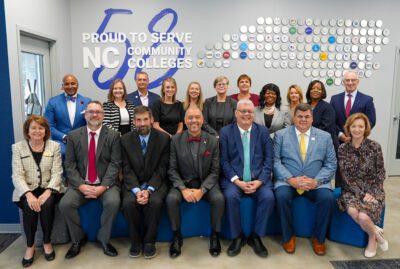
In 2014, North Carolina higher education took a big step for transfer by revising and strengthening the Comprehensive Articulation Agreement (CAA). Today, students better understand which credits are most likely to transfer to which colleges. As a result, more North Carolinians earn the credential they need to fill the emerging opportunities in the workforce.
To meet the growing demand from employers, we must take more steps on behalf of transfer. In the previous installments of our community college transfer series, we addressed: “Why transfer?” and, “Who should transfer — but is not?”
In this installment, we ask, “How do we improve transfer?”
North Carolina’s 58 community colleges — widely known as the “Great 58” — transform lives by providing high-quality, accessible and affordable educational opportunities that translate to family-sustaining careers.
They are economic engines — attracting employers and jobs to communities across the state — and serve as critical points of entry to baccalaureate-granting institutions. With campuses in rural and urban communities, any North Carolinian can begin their higher education journey close to home, at an institution that is far less expensive and more responsive to their needs.
Extraordinary talent can be found at each and every campus. The problem is that currently, fewer than half of students are transferring and earning bachelor’s degrees. They are losing a pathway to higher-wage jobs and greater economic security.
In the last installment of our series, we emphasized that beyond simply focusing on increasing the number of transfers, community colleges and 4-year institutions must also ensure that the transfer journey is clear, affordable, and efficient. At the end of the day, North Carolina is counting on more students earning bachelor’s degrees to remain No. 1 in business.
Where do we begin?
Strategies to strengthen transfer
Maximizing credit transfer
Imagine: Jemilia, a North Carolina community college student, easily accesses her academic records and sees how her credits would transfer at every institution in the University of North Carolina System (UNC System). Helpful, right?
Unfortunately, this interactive data system does not exist. Granted, researchers might be able to see the credits our state’s public colleges accept and apply toward students’ degrees of interest. However, we have no easy way to know the courses that do not transfer, and in practice, you must evaluate each individual transcript.
What we need is a central, statewide, open-access transfer platform, where students like Jemilia can see the UNC institutions that accept each North Carolina Community College System course — and for which disciplines.
This is not out of reach.
Community colleges across the state have already established common course numbers. The UNC System Office followed suit by identifying comparable courses across their institutions. It may seem like a small step — courses at both the sending and receiving institutions sharing the same designation. That shared number signals community college course and UNC System course equivalency. And that’s significant when you consider that equivalencies are now in place for more than 1,600 undergraduate, lower-level courses across all 16 UNC universities.
But we must build on this foundation.
Let’s extend common course numbers to major requirements. We can start with disciplines in our fastest-growing fields like information technology, financial services, and nursing.
Aligning pathways to local workforce opportunities
After all, every community needs more accountants, auditors, engineers, and medical professionals. We need to ensure courses and credits map to the skills students will need in their careers.
Simply put, more students need access to these pathways — especially those in Associate of Applied Sciences majors. The positive news? Colleges are catching on, with some developing articulation agreements in programs like applied nursing and engineering. For example, East Carolina University’s set of bilateral transfer agreements in the Colleges of Allied Health Sciences and Business with community colleges across the state.
But there is no central resource for students to obtain this information. Any transfer platform we develop must make it clear which schools offer these pathways.
We also must acknowledge that as workforce needs change, so too must our transfer pathways. That’s why we need to make certain that faculty across disciplines and institution types regularly convene to update sets of equivalencies and pathways.
Our higher education system needs to keep pace with economic trends. And we need to ensure an organization is clearly tasked with updating any student and advisor-facing online resources to reflect those changes.
Transfer is a team effort
Revising the Comprehensive Articulation Agreement required buy-in from higher education leaders, policymakers, and practitioners across the state. So did the common course numbering system.
Today, we need to take another big step for transfer in the face of surging demand for bachelor’s degrees. We need K-12 and business leaders to join the fold and emphasize that transfer provides high-value, affordable pathways to bachelor’s degrees — and high-wage jobs.
Recommended reading



